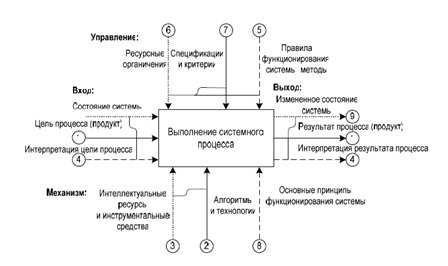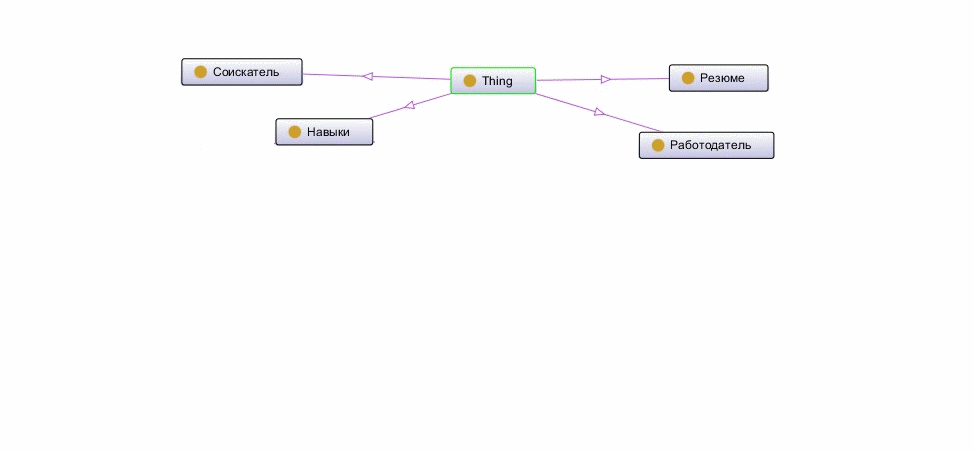Abstract
Content
- Introduction
- 1. Theme urgency
- 2. Goal and tasks of the research
- 3. Justification of the choice to select ontological knowledge base
- 4. Selecting method for creating ontology
- 5. Example of creating an ontology for recruitment system
- Conclusion
- References
Introduction
The development and use of ontologies is one of the new information technologies, purpose of which is can be defined as support for collaborative problem solving processes, ie, the ability to provide the same understanding by all users of meaning applied terms for solving, their attributes and the relationships between them. The term "ontology" in general can be interpreted as type of network model of domain knowledge. At the informal level ontology — a description of some subject area, which consisting of terms and using rules. In a formal treatment ontology is a system consisting of concepts and a set of assertions about these concepts on which you can build classes, objects, relations, functions, and theory.
In information technology, the term "ontology" is used in the context of the following concepts: conceptualization; knowledge, knowledge model, the system based on knowledge. Conceptualization is the process of transition from view domain of natural language to the exact specifications of this description in some formal language that targets the computer representation. One of the most common is the definition according to which the ontology is the greatest (expressed by formal means) specification of a conceptualization. On the basis of the above definitions, we can highlight the following: in the framework of the application of information technology in the field of ontology — is formally represented domain knowledge based on the description of the set of concepts (concepts) domain of knowledge about, and links (relationships) between them.
1. Theme urgency
Progress in the field of information technology has led to the accumulation of large amounts of electronic resumes variety of formats. The task of finding specific information in the screen becomes difficult year by year. One possible solution to this problem could be tied to a semantic description of the documents in the form of ontologies, or other types of semantic descriptions of the object.
2. Goal and tasks of the research
The target of the research is to develop an ontological knowledge base for recruiting system comprising a glossary subject area and the logical links that describe how these terms relate to each other.
Main tasks of the research:
- Definition of terms in the domain and the relationships between them.
- Choice of ontology creation.
- Creating a domain model.
- Defining classes, class hierarchies and their properties.
- Development ontological knowledge base.
- Сreate search subsystem for suitable candidates.
Research object: Recruiting domain.
Research subject: Methods of designing and creating ontologies.
3. Justification of the choice to select ontological knowledge base
In recent years the development ontologies - formal descriptions of explicit terms in the domain and the relationships between them — moves from the world of artificial intelligence laboratories to the desks of experts in the subject areas. This can be explained by the following reasons for using ontologies:
- Ability to reuse knowledge in the domain.
- In order to make assumptions explicit in the subject area.
- To separate domain knowledge from the operational knowledge.
- For analysis of domain knowledge
Enabling reuse of domain knowledge has become one of the driving forces behind the recent surge in the study of ontologies. For example, models of many different subject areas is necessary to formulate the concept of time. This presentation includes the concept of time slots of times, relative measures of time, etc. If one group of scientists will develop a detailed ontology, others may simply re–use it in their subject areas. In addition, if we need to create a large ontology, we can integrate several existing ontologies describing a large part of the domain.
Make explicit assumptions about the domain of the underlying implementation, makes it easy to change these assumptions change in our knowledge of the subject area. Hard coding assumptions about the world in a programming language leads to the fact that these assumptions are not only difficult to find and understand, but also difficult to change, especially a nonprogrammer. In addition, the explicit specification of domain knowledge useful for new users who need to know the values of terms in the domain [7]. The use of ontological knowledge base for the creation of a system of recruitment can cope with such a complex issue as the specification of the negotiation skills of the applicant, which may be interpreted ambiguously by different specialists.
In the center of most ontologies are classes. Classes describe concepts or terms of the domain. However, the development of ontologies is different from designing classes and relations in object–oriented programming. Object–oriented programming focuses primarily on methods of classes — the programmer design decisions based on the properties of the class of operator, while the developer of the ontology makes these decisions based on the structural properties of the class. As a result, the class structure and the relationships between classes in the ontology different from the structure of such a domain in an object–oriented program.
Sharing human or software general understanding of the structure of information is one of the most common goals of ontology development. Therefore, the use of ontologies in the recruitment system will determine the glossary given subject area, including a clear description of the potential skills of the applicant, the same ontology will describe a hierarchy of skills and their relationship to each other. Here, under the skill of the applicant refers to certain professional knowledge and skills required to work on a candidate for a post
4. Selecting method for creating ontology
To solve our problem are invited to explore the use of these methods for designing ontologies: hierarchical, system–cognitive. There is no single "correct" way or methodology for developing ontologies, but knowing for what we're going to use the ontology and how detailed or general, it will have an impact on many decisions regarding the simulation. Therefore it is necessary to identify the main challenges that must be addressed with the help of our ontology:
- — the creation of a common vocabulary terms of the organization;
- — a hierarchy of concepts (taxonomy) that characterize the activity of the system;
- — optimization of search and navigation, finding the distance from the vacancy created by the employer to the resume of the applicant, by the relation skills;
- — solution to the problem of integration of heterogeneous databases and data warehouses.
Consider a system-cognitive approach, the methodology of this modeling, designed for analysis and decision making in ill-defined situations was proposed by R. Axelrod [8]. It is based on the modeling of subjective views of experts on the situation and includes: a methodology for structuring the situation; model representation of expert knowledge and the methods of analysis of situations. The task of cognitive modeling is the identification and description of the abstract or existing correlated phenomena, events that take place in the facility control and management. The cognitive tool allows to reduce the complexity of the study, formalization, structuring and modeling of the system.
domain model in the cognitive model is represented as a signed directed graph with feedback. At the vertices of the graph are the various key elements of the event or situation. Arcs connecting the vertices represent causal relationships between them. It is essential that event parameters and the degree of their mutual influence can be expressed as a precise quantitative parameters and qualitative fuzzy relations. Node of the graph can be interpreted with the help of diagrams for functional simulation IDEF0 (see Fig. 1), which is usually at the entrance has a purpose of the process, the output — the result of a process that is provided on the basis of the specifications and criteria with the use of algorithms and techniques. However, for a more detailed, expressive description of the process must also take into account semantic and pragmatic aspects of complex systems. Therefore, at the semantic level are discussed further at the entrance - the interpretation of process goals, the output — the interpretation of the process are taken into account in the management of the rules of the system, by using the tools — the basic principles of the system. On a pragmatic level, the state of the system are taken into account and the changed state of the system resource constraints, intellectual resources and tools [9].

Figure 1 – Node signed directed graph
This approach reflects the relationship between the situation and the processes occurring in the subject area, as well as the goal is to support decision making in a given situation, that is not the purpose of our system, because Our system will analyze objects and classes.
The hierarchical approach includes the following steps:
- — defining classes in the ontology;
- — the location of the classes in the taxonomic hierarchy (a subclass - superclass);
- — definition of class properties and a description of allowed values of the properties;
- — filling in the values of slots copies.
This method will build a clear hierarchical model skills of applicants, as well as add the ability to set its level. Such a model will greatly simplify the task of finding the optimal implementation of the candidate and will find him a degree of competence in the extended position. So in the future when creating an ontology is used hierarchical approach.
5. Example of creating an ontology for recruitment system
As an example of creating an ontology used software tool «Protege», which allows you to declaratively describe the ontology defining explicitly what the class hierarchy and which classes are individual concepts belong. The structure of the ontology as a graph shown in Fig. 2.

Figure 2 - Example of ontology for recruitment system (animation: 4 frames, 5 cycles of repetition, 49.4 kilobytes)
After creating a hierarchical knowledge base implementation of finding suitable candidates nominated by the employer requirements is reduced to finding the distance from job to job seekers.
References
- Gruber T.R. A translation approach to portable ontologies // Knowledge Acquisition, 1993.
- Бениаминов Е.М. Алгебраические методы в теории баз данных и представлении знаний. М.: Научный мир, 2003.
- Guarino N. Formal ontology in information systems // Proceedings of FOIS’98, Trento, Italy, 6-8 June 1998. Amsterdam, IOS Press, 1998. 3-15.
- Когаловский М., Калиниченко Л. Концептуальное моделирование и онтологические модели // Онтологическое моделирование. Труды симпозиума в г. Звенигороде, 19-20 мая, 2008.
- Межуев В.И. Использование онтологий как моделей предметных областей / «Искусственный интеллект» 4’2009, 4-11 с.
- Крошилина С.В., Крошилин А.В., Каширин А.Ю. Автоматизированный анализ деятельности предприятия с использованием семантических сетей / А.В. Крошилин. — М.: Горячая Линия — Телеком, 2011. — 140с.
- Гаврилова Т.А., Хорошевский В.Ф. // Базы знаний интеллектуальных систем. — СПб.: Питер, 2001. — 384 с.
- Natalya F. Noy, Deborah L. McGuinness Ontology Development 101: A Guide to Creating Your First Ontology / Stanford University, Stanford, CA, 94305 [Электронный ресурс]. — Режим доступа: http://protege.stanford.edu
- Попов Д. В., Поляковский С. Ю., Мухачева Н. Н. Математическое и программное обеспечение конфайнмент–моделирования сложных систем // Принятие решений в условиях неопределенности: Межвуз. науч. сб. Уфа: Уфимск. гос. авиац. техн. ун–т, 2007. С. 19–26.
- Нифталиев В.Э., Привалов М.В., Создание онтологической базы знаний рекрутинговой системы (ИУС-2013) / Материалы IV международной научно–технической конференции студентов, аспирантов и молодых ученых. — Донецк, ДонНТУ — 2013, Том 2, с. 57–61.
- Н.Н. Мухачева, Д.В. Попов Системно–когнитивный подход к построению онтологических баз знаний информационно–интеллектуальных ресурсов // Вестник РГРГТУ. № 4 (выпуск 30). Рязань, 2009. С. 123–135.
